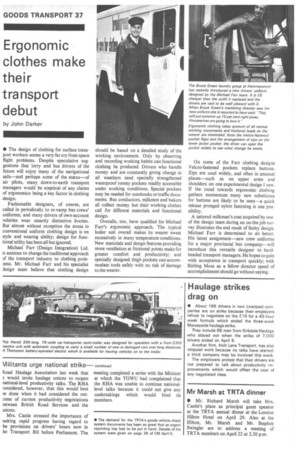Ergonomic clothes make their transport debut
Page 39

If you've noticed an error in this article please click here to report it so we can fix it.
by John Darker • The design of clothing for surface transport workers seems a very far cry from space flight problems. Despite speculative suggestions that lorry and bus drivers of the future will enjoy many of the navigational aids—and perhaps some of the status—of air pilots, many down-to-earth transport managers would be sceptical of any claims of ergonomics being a key factor in clothing design.
Fashionable designers, of course, are called in periodically to re-vamp bus crews' uniforms; and many drivers of own-account vehicles wear smartly distinctive liveries. But almost without exception the stress in conventional uniform clothing design is on style and wearing ability; design for functional utility has been all but ignored.
Michael Farr (Design Integration) Ltd. is anxious to change the traditional approach af the transport industry to clothing probems. Mr. Michael Farr and his specialist iesign team believe that clothing design should be based on a detailed study of the working environment. Only by observing and recording working habits can functional clothing be produced. Drivers who handle money and are constantly giving change in all weathers need specially strengthened waterproof roomy pockets readily accessible under working conditions. Special pockets maybe needed for notebooks or traffic documents. Bus conductors, milkmen and bakers all collect money but their working clothes call for different materials and functional design.
Overalls, too, have qualified for Michael Farr's ergonomic approach. The typical boiler suit overall makes its wearer sweat .excessively in many temperature conditions. New materials and design features providing more ventilation at frictional points make for greater comfort and productivity; and specially designed thigh pockets can accommodate tools safely with no risk of damage to the wearer.
On some of the Farr clothing designs Velcro-fastened pockets replace buttons. Zips are used widely, and often in unusual places—such as on upper arms and shoulders on one experimental design I saw. If the trend towards ergonomic clothing gathers momentum many new substitutes for buttons are likely to be seen—a quick release pronged nylon fastening is one possibility.
A tattered milkman's coat acquired by one of the design team during an on-the-job survey illustrates the end result of faulty design. Michael Farr is determined to do better. His latest assignment—new crew uniforms for a major provincial bus company—will introduce this versatile designer to hardheaded transport managers. He hopes to gain wide acceptance in transport quickly; with Stirling Moss as a fellow director speed of accomplishment should go without saying.








































































































































